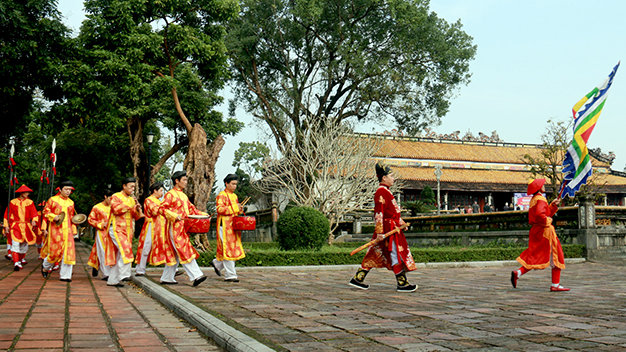Authorities in a central Vietnamese province have decided to earmark almost US$7 million for restoring scores of relics belonging to a UNESCO-recognized complex this year.
The Hue Monuments Conservation Center in Hue – which is the capital of Thua Thien-Hue Province – on Wednesday embarked on a restoration project to revamp 22 relics of the Hue Complex of Monuments.
The revamp, expected to cost VND150 billion (US$6.99 million) is meant to restore the relics’ original charms and boost their appeal to tourists, according to Phan Thanh Hai, director of the center.
One of the relics to be revamped this year is Phu Van Lau (Pavilion of Edicts), Hai said.
Located in front of the Royal Palace’s flag pole and built in 1819, Phu Van Lau was where important documents from the Nguyen court were posted.
The edifice has been restored ten times but it has sustained serious damage recently.
In mid-May last year, part of the structure collapsed, which triggered an alarm among the local government and residents.
Restorations will also take place at the Royal Palace, the King Tu Duc Mausoleum and Thieu Phuong Garden, among others.
Several other noted relics including Ngo Mon (Gate of Noon), Thieu Tri King’s Mausoleum, Trieu To Mieu (the Nguyen Ancestry Temple), and Tang Tho (Hidden Books) Edifice will also see further repairs.
Built in 1804, Trieu To Mieu was used to worship Nguyen Kim, father to the Nguyen Dynasty’s pioneering lord.
Since 1989, the edifice has suffered serious damage, including walls being scaled off, inscriptions fading, and tiled roofs leaking.
Meanwhile, the Tang Tho Edifice was built in 1825 during the reign of King Minh Mang (1791-1841), the second Nguyen king.
The mansion was among the very few architectural works in Hue which were built totally from traditionally mortared bricks.
In 2014, the Hue Monuments Conservation Center conducted restorations totaling VND105.4 billion ($4.91 million) on 17 relics.
It also compiled and published over 20 research works on Hue heritage, scores of noted music works on UNESCO-recognized “nhac cung dinh” (courtly music) and staged over 25 excerpts from ancient court “tuong” (traditional Vietnamese opera) plays during art exchanges.
The center earned over VND139 billion ($6.48 million) in relic ticket revenue last year.
It expects to receive 3.1-3.3 million tourist visits this year, including 1.1-1.3 million international tourists, and rake in VND170-175 billion (up to $8.16 million) in revenue.
Hue was Vietnam’s imperial capital during the Nguyen Dynasty (1802-1945), the country’s last monarchy.
The Complex of Hue Monuments earned UNESCO recognition in 1993.
It is located in and around Hue City in the geographical center of Vietnam and with easy access to the sea, UNESCO says on its website.
Established as the capital of unified Vietnam in 1802, Hue was not only the political but also the cultural and religious center under the Nguyen Dynasty from 1802 to 1945, the UN agency adds.
Like us on Facebook or follow us on Twitter to get the latest news about Vietnam!




















































